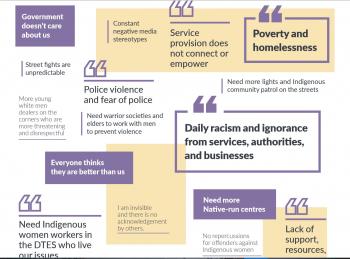Image Caption
Summary
Windspeaker.com Contributor
Red Women Rising is a rare offering: the report’s experts are its subject.
“It’s rare that women in (Vancouver’s Downtown Eastside) are considered as experts, not only in their own lives, but also in terms of policy solutions and systemic change that needs to happen. This report is unprecedented at placing Indigenous women at the centre of research, of community participation, Indigenous methodology,” said Harsha Walia, the Downtown Eastside Women’s Centre’s project co-ordinator.
The 220-page report, authored by Walia and the centre’s victim services worker Carol Muree Martin, was released April 3. It centres on the lives of 113 Indigenous survivors of violence (women, girls, trans and two-spirited people) and 15 non-Indigenous women who are friends or street families of Indigenous women who are missing, have overdosed or died from violence.
“The Downtown Eastside is one neighbourhood, but of course this reality exists across these lands,” said Walia.
“This report is comprehensive and compelling,” said Grand Chief Stewart Phillip of the Union of British Columbia Indian Chiefs.
The figures presented in the report are disturbing: 24 per cent of homicide victims are Indigenous women; Indigenous women are eight times more likely to be abused than non-Indigenous women; 36 per cent of Indigenous women live in poverty, slightly more than double their non-Indigenous counterparts. Indigenous women and girls are over-represented in statistics on homicides, poverty, homelessness, child apprehensions, police street checks, incarceration, and overdose fatalities.
But the stories, first-hand realities of violence, residential schools, colonization, land, resource extraction, family trauma, poverty, labour, housing, child welfare, police, prisons, legal system, opioid crisis, healthcare and more, are heartbreaking.
“I grew up in a really violent home. My dad was really violent and my mom had black eyes all the time. We used to be really scared of him especially when he drank. My mother died when I was 17 years old, when I really needed her,” said Corinne Ducharme, a Cree woman.
For Marlene Jack of the Cheslatta Carrier nation, abuse was both in her home and her community. “Our father … being strict and an alcoholic was a result of his time in residential school. He would beat us up out of the blue sometimes. When I was older I got beat up in my community and no one helped me.”
Marge Humchitt talks about leaving her Heiltsuk community in Bella Bella after being outed as a lesbian. She relocated to Vancouver.
“I have been beaten up, been knifed, been raped, and spent time in jail,” she recounts. “I have also had negative experiences with the police. I remember contacting them after a violent incident and it took them hours to show up. When they did show up, they did not take me seriously.”
The compelling stories, rigorous research, and holistic recommendations within the report drastically and urgently shifts the lens from pathologizing poverty towards amplifying resistance to and healing from all forms of gendered colonial violence, says the Yellowhead Institute, a think-tank for Indigenous issues.
Walia admits the 200 recommendations outlined by the report “are overwhelming because there are so many issues to be tackled and they’re all connected.”
The recommendations are based on guiding pieces that aren’t necessarily new, she says. The three core principles are the implementation of Indigenous jurisdiction, going back to the key issue of land and ending colonization, implementing the United Nations Declaration on the Rights of Indigenous Peoples; active leadership by Indigenous women at all levels of government to determine policies, services and solutions; and ending structural violence by addressing all socio-economic factors.
Walia says she doesn’t know whether the National Inquiry for Murdered and Missing Indigenous Women and Girls will identify the same core principles.
“Our main concern is less with the national inquiry. We did participate and we were grateful to be able to submit and receive standing. Our main question is less the national inquiry than the government,” she said.
Walia stresses it’s not only about the federal government taking steps, but it’s about all levels of government taking action. And it’s not only about the 200 recommendations in Red Women Rising being implemented, it’s about the recommendations from the final report of the National Inquiry for Murdered and Missing Indigenous Women and Girls (due April 30) being implemented, and every recommendation from every previous report also being implemented.
While Red Women Rising doesn’t offer any dollar figures to go along with the recommendations, Walia highlights one study that says that for every $10 spent on housing $21 is saved in related costs in health care, justice, shelters, and other social supports.
“Of course our main concern is the ethical perspective, but even from an economics perspective, providing services to ensure that Indigenous women, girls, trans and two-spirit people have safety costs less to the system than keeping people (going) with emergency Band-Aid solutions,” she said.
It’s also important, says Walia, for non-Indigenous Canadians to learn about the women in the report.
“Every single person who comes across this report (needs) to sit with it, read women’s diverse stories … to come to terms with individual person’s story and dreams and journeys and to think through that…
“We all have a role to play. Certainly the biggest role is with government, but we all have a role to play in transforming these conditions,” she said.
Read the report here: https://mm.aiircdn.com/472/5ca638ae21ba3.pdf

